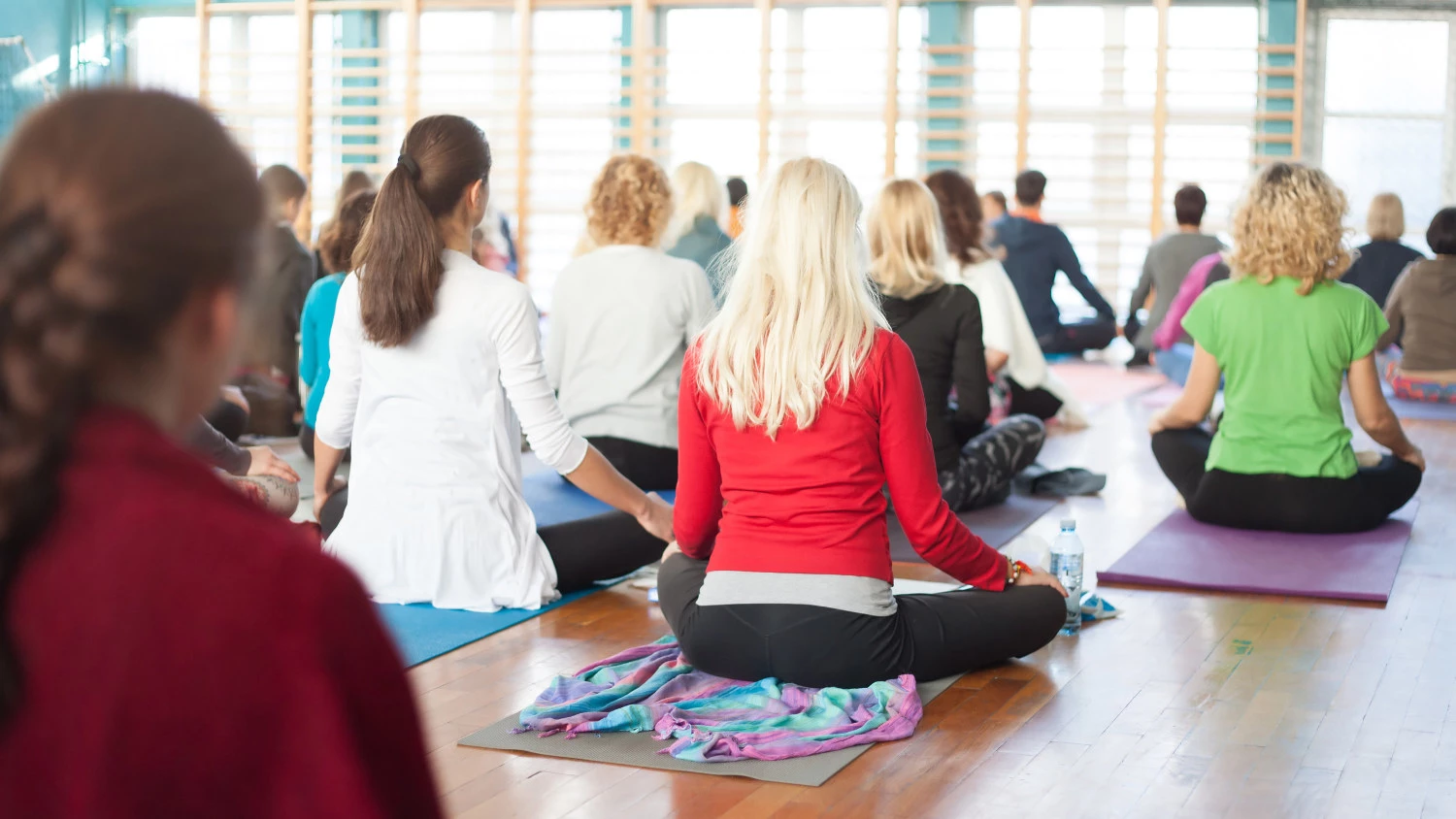Natasha Rizopoulos on Teaching Yoga: Moving from Louder and Faster to Slower and Quieter

It’s easy to get seduced by the sweat of a vigorous, gymnastics-oriented Power Yoga practice and ignore the metaphysical context, writes yoga teacher Natasha Rizopoulos in this blog post.
However, as yoga teachers, it behooves us to get more adept at sharing the wisdom of the lineage rather than dumping it overboard at the first sign of confusion or discomfort in students.
I recently read an article about a popular Asana teacher who makes a point of eschewing any reference to the less Western elements of Yoga — Sanskrit, chanting, “spirituality” etc. — because these aspects supposedly scare Americans away from Yoga and she wants to make the practice accessible to as many people as possible.
I’m all for throwing open the Yoga doors, but rather than simply rejecting the traditions and historical context that separate Asana from aerobics, how about we all just get a little more skillful at translating the parts that might initially seem mysterious?
Making Yoga Accessible to All: Demystifying and Translating the Yogic Philosophy
I’ve been inspired by many teachers who integrate the Yoga lineage into their teaching without being esoteric or alienating. And in my own experience it can be tremendously potent to use time on the mat as a vehicle for understanding Yogic philosophy on both a practical and personal level.
Because simply doing poses isn’t practicing Yoga. Facility with Handstand is gymnastics unless it is accompanied by a quality of mind that emphasizes integrity of effort over results. And that idea is articulated in every imaginable and beautiful way in the Yoga Sutra and other seminal texts.
While this basic premise is as clear as day to me now, it wasn’t always. Once upon a time I banged my way through Power Yoga with such mindless enthusiasm that I injured my back so badly I couldn’t walk (or sit or stand) for 2 weeks. I recovered, but blithely plunged back in with similar results.
Looking back, I wish I had had some familiarity with Patanjali, or that a teacher had introduced the idea of “Heyam duhkham anagatam” (Pain that has not yet come is avoidable) as a possible course correction for my well-intentioned but confused ambition on the mat.
I did have one friend who was a serious Iyengar student, and I would regale him with tales of how hard I had worked in class and the general butt-kicking of it all. I remember he would get this kind of pained expression on his face and try to gently suggest that he didn’t really think that was the point.
At the time I had no idea what he was talking about, and absent any larger vision about the practice, thought he was quite the buzz kill.
“When you practice poses without some kind of narrative about the big picture of it all, you miss so much.”
So I understand the impulse to get seduced by the sweat and ignore the metaphysical context. And perhaps because of my origin story, and how completely I missed the boat at the beginning of my practice, I think that as teachers it absolutely behooves us to get more adept at sharing the wisdom of the lineage rather than dumping it overboard at the first sign of confusion or discomfort.
Because when you practice poses without some kind of narrative about the big picture of it all, you miss so much. Yes you’ll probably get physically stronger and more flexible, and maybe even lose some weight.
But that’s not the juicy stuff. The really good stuff is about getting mentally stronger and more flexible and lightening up in other ways (it’s exhausting and onerous to spin in mental circles all the time).
Most of us fell in love with Yoga because it made us feel better. And of course the hours you spend on the mat are powerful and important in and of themselves. But the real changes happen when you learn to apply your experience with Asana to the rest of your life (and vice versa).
And the tools for that process are in the lineage (the texts, the stories, the chants, etc.) and are begging to be woven into the physical practice. Not in some pedantic or obscure way, but quietly and consistently as part of an ongoing conversation that informs the practice.
Asana provides the perfect vehicle for understanding these ideas in ways that are immediate and empirical. It’s the ideal place to draw the attention inward and start to observe the subtle nuances of your experience; how the tone of breath changes the quality of the mind, how a half-inch shift in a hand or foot reshapes a pose, how an OM creates a vibration that changes the energy in a room.
Getting Beneath the Surface to Feel Genuine in Your Yoga Teaching
All of the above require a basic interest in what’s beneath the surface, and in a world that is very interested in louder and faster, it is true that slower and quieter can seem to be a hard sell.
But perhaps not so hard when you can use thousands of years of wisdom about the human condition as a frame of reference. And perhaps not so hard when you can lead a short (translated) invocation that connects students to something bigger than the state of their hamstrings on a given day.
Doing these things doesn’t need to scare people away if it’s done from a place of simplicity and sincerity. I didn’t chant OM in my classes until I had been teaching for several years because it didn’t feel genuine until then. I didn’t talk about the Sutras until they made sense to me deep in my bones.
And when I do include any of the traditional elements of the lineage, people are generally appreciative and responsive. At the end of every Teacher Training I lead, many of the students write that spending time with the Philosophy was the unanticipated highlight of the course.
So consider experimenting by pushing any small amount beyond the apparent comfort zone. Do it gently, and only in those ways that specifically resonate, because that authenticity will translate to others.
I didn’t expect to become captivated by chants and texts of Classical Yoga. But I eventually came to them because teachers I admired incorporated them into their classes and made them comprehensible and profound and real. I’m so grateful that they did.
Study with Natasha online. YogaU is proud to feature Natasha as part of our YogaU Practice Channel. Go here to see a list of her practices: yogauonline.com/teachers/natasha-rizopoulos
Reprinted with permission from natasharizopoulos.com
 As a former ballet dancer, Natasha Rizopoulos knew she had come home when she discovered yoga in her 20s. Now a Senior Teacher with YogaWorks and Down Under Yoga, and a writer, teacher, and DVD instructor for Yoga Journal, Natasha is known world-wide for her ability to communicate the essence of sophisticated postures and ideas in ways that have a transformative effect upon one’s understanding of yoga. Her yoga training includes extensive studies in both the Ashtanga yoga and the Iyengar yoga systems; these two traditions continue to inform her teaching, creating a dynamic and rigorous blend of intelligently sequenced and aligned Vinyasa Flow.
As a former ballet dancer, Natasha Rizopoulos knew she had come home when she discovered yoga in her 20s. Now a Senior Teacher with YogaWorks and Down Under Yoga, and a writer, teacher, and DVD instructor for Yoga Journal, Natasha is known world-wide for her ability to communicate the essence of sophisticated postures and ideas in ways that have a transformative effect upon one’s understanding of yoga. Her yoga training includes extensive studies in both the Ashtanga yoga and the Iyengar yoga systems; these two traditions continue to inform her teaching, creating a dynamic and rigorous blend of intelligently sequenced and aligned Vinyasa Flow.



